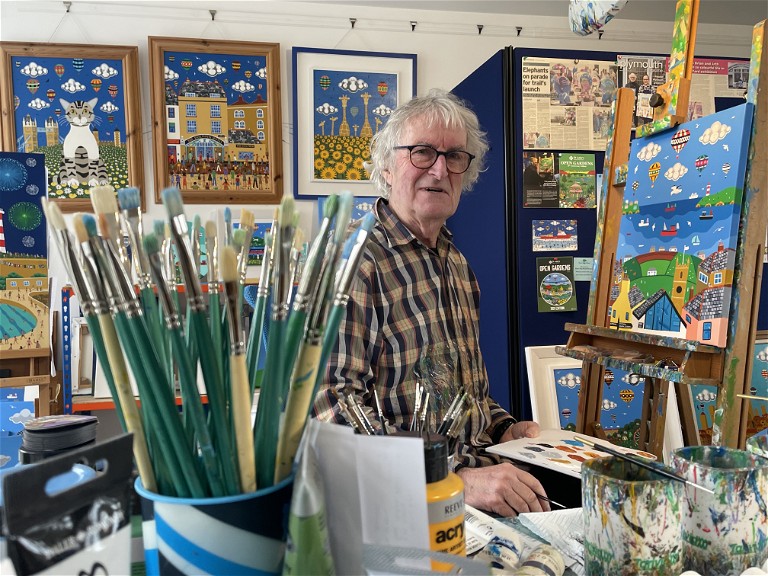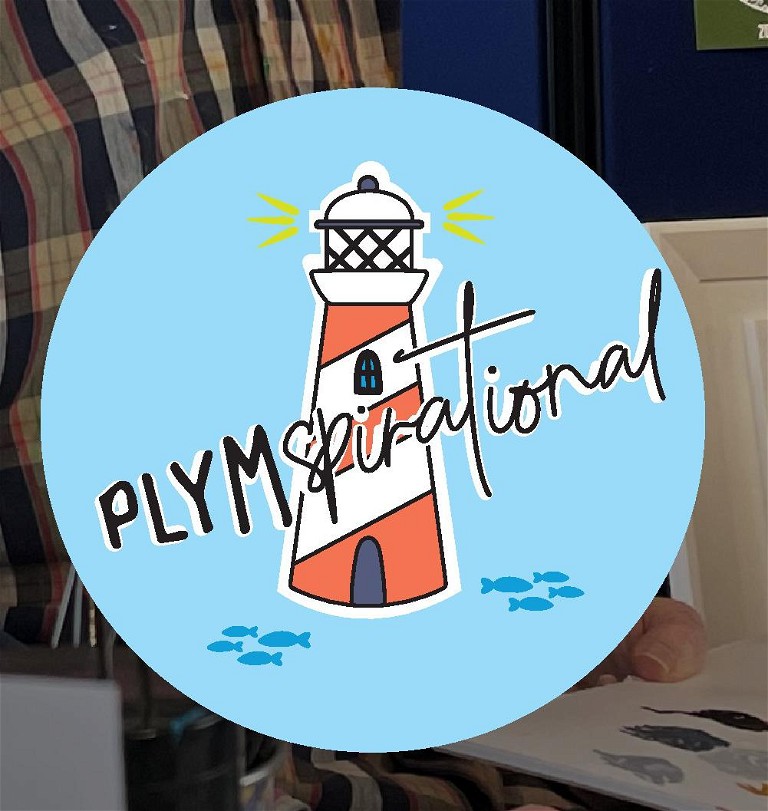“Plymouth has the most astonishing history”

Artist Brian Pollard is famous for his colourful paintings of Plymouth’s waterfront. His unique and playful style often features Smeaton’s Tower and Plymouth Sound, among lots of other beauty spots in the Southwest.
Brian’s paintings are familiar to many Plymothians.
His colourful works can often be seen decorating the windows of galleries and shopfronts on the Barbican, but his work has far broader appeal than just Plymouth.
From Brian’s garden-studio, an uninterrupted view of the shoreline and horizon can be seen as he sketches his latest work. “You’re not allowed to photograph this one” he said. “This is a surprise gift for a friend.”
The artist moved to Plymouth from the Birmingham in 1977. After qualifying as a medical doctor, he worked as a GP in an inner-city NHS Practice for 30 years.
For Brian, the highly stressful environment of medicine forged a direct path to taking up painting as a hobby. The relaxation of getting lost in an image offered a form of stress relief, something to take his mind off work. “The process of painting is very relaxing”, he said. “You really focus on what you’re doing, in the moment.”
Brian added that his paintings being so bright and colourful were also a factor in cheering him up whenever he got the brushes out.
His GP surgery would play an unexpected role in his artistic success. “I used to hang up my pictures in the waiting room of my surgery”, Brian explained. “One of my patients was a gallery owner and he quite took to them, that’s how they got into a gallery in the first place.”
He added: “I put my work in galleries by invitation only.
I wrote to a gallery once and they were so rude to me it could put you off painting for the rest of your life.”
Eventually, he was asked to exhibit his work in a gallery in London. A friend of Brian’s ran a hotel, which had its own in-house art gallery. The exhibition caught the eye of an art critic for national newspaper, the Mail on Sunday.
Brian said: “I held an exhibition there and that’s when things really changed. After the art critic from the Mail on Sunday reviewed the display – tickets sold out in about 45 minutes.”
Luckily the review was very favourable of his work. “It wasn’t considered ‘great art’, but he recognised that people really liked it and suggested that you should come and see my work to cheer up your day.”
He continued: “The same critic then came down to Plymouth and reviewed an exhibition I held here, which was astonishing. That’s when I started getting national attention.”
After some success, Brian wanted to focus on inspiring others to pick up the paint brush. He has worked extensively with schools across Plymouth, visiting almost every primary school in the city, in the hope of igniting a 10 passion for paint. He said: “You either hate this sort of art, or you love it. But either way, it attracts people. It’s why I visit children in schools, it gets people involved.
“I take children out on the waterfront and show them in real life. It’s quite surprising, some children in the city have never been out on the Hoe before.”
According to Brian, one of the best things about being involved in community projects is being invited to places you would normally never go. A stark difference to his career as a GP, he says. One particular event that comes to mind was the auctioning of Plymouth’s Elmer the Elephant sculptures, the very first one of which was designed by him. The elephant sculptures were placed throughout the city and auctioned off to raise money for St Luke’s Hospice.
Brian is full of stories and interesting tales about Plymouth. It was in the city that he met David McKee, the creator of the enormously popular Mr Ben books, which were turned into the children’s television show. As it transpires, the inspiration for Mr Ben came from a shop in Ebrington Street in the city centre. The author of Mr Ben once visited a store there, where the owner would appear “like magic” but seemed rather irritated by the idea of actually selling anything. This would form the basis of the fancy dress shop, featured in the story.
Brian even had a piece of music composed for schoolchildren to sing for the launch of the Elmer the Elephant auction. He arranged for Duncan Lamont, a jazz saxophonist, who became famous for writing the music for the Mr Ben cartoon. Sadly, on his way to hear the music performed for the first time, Duncan suffered a heart attack and passed away at Derriford Hospital.
Brian sees the city as a great place for budding artists with a very bright future. The re-opening and development of Drakes Island is a particularly welcome change. “I never painted Drake’s Island”, said Brian, in protest. “The island used to be used for children to go and visit for canoeing, climbing and all sorts of activities. So, I said until it’s returned to that, I will not paint it.”
Now, Drake’s Islands has a new owner, who has welcomed classes of schoolchildren to visit once again and has plans to build a hotel on the island. Brian now happily draws the Island in his paintings. Some of which can be spotted in his most recent works.
The history of the island, and of Plymouth generally is of particular fascination for the artist. Charles Darwin, Lawrence of Arabia, and even Napoleon, just a few of the historic names to have visited Plymouth Sound. But it’s the landscape that is the foremost inspiration for his work:
“We’re sandwiched between the Moors and the Sea and right next to Cornwall. What more could you ask for? The two most beautiful counties in the country!”
“I think the city still has much more potential to be realised. Things happen slowly and sometimes people are reluctant to spend money on arts and cultural things which is understandable, but I think that is changing.”
For any budding artists, Brian has some simple advice.
If you want to paint in a realistic style, then you ought to try some lessons, but if you are looking to paint in the ‘naïve’ style as he calls it, then you just have to paint on a regular basis.
“My art . . . people say ‘it’s the Hoe’ because it has water and a lighthouse but in reality, it isn’t anything like what the Hoe looks like. There’s lots of stuff missing, because it’s either too complicated or it doesn’t fit-in. When you’re not trying to achieve something that looks photographic, that’s what you’re trying to do.
“Art is all about observation, looking at things very, very carefully.”
Without doubt, this is something that the people of Plymouth hope he continues to do, for a long time to come.
